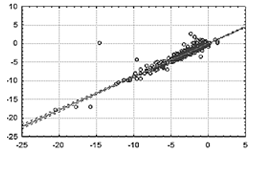This study follows the occurrence of refractive errors in population and the possible selection of the appropriate type of corrective aids. Objective measurement and subsequent determination of the subjective refraction of the eye is an essential act in opotmetric practice. The file represented by 615 patients (1230 eyes) is divided according to the refractive error of myopia, hyperopia and as a control group are listed emetropic clients. The results of objective and subjective values of refraction are compared and statistically processed.
Methods: The study included 615 respondents. To determine the objective refraction the autorefraktokeratometer with Placido disc was used and the values of spherical and astigmatic correction components, including the axis were recorded. These measurements were subsequently verified and tested subjectively using the trial lenses and the projection optotype to the normal investigative distance of 5 meters. After this the appropriate corrective aids were then recommended.
Results: Group I consists of 123 men and 195 women with myopia (n = 635) of clients with an average age 39 ± 18,9 years. Objective refraction – sphere: -2,57 ± 2,46 D, cylinder: -1,1 ± 1,01 D, axis of: 100° ± 53,16°. Subjective results are as follows - the value of sphere: -2,28 ± 2,33 D, cylinder -0,63 ± 0,80 D, axis of: 99,8° ± 56,64°. Group II is represented hyperopic clients and consists of 67 men and 107 women (n = 348). The average age is 58,84 ± 16,73 years. Objective refraction has values - sphere: +2,81 ± 2,21 D, cylinder: -1,0 ± 0,94 D; axis 95° ± 45,4°. Subsequent determination of subjective refraction has the following results - sphere: +2,28 ± 2,06 D; cylinder: -0,49 ± 0,85 D, axis of: 95,9° ± 46,4°. Group III consists from emetropes whose final minimum viasual acuity was Vmin = 1,0 (5/5) or better. Overall, this control group is represented 52 males and 71 females (n = 247). The average age was 43 ± 18,73 years. Objective refraction - sphere: +0,32 ± 0,45 D; cylinder: -0,51 ± 0,28 D, axis of: 94,7° ± 57,5°.
Discussion: Values of objective refraction take higher values than the subsequent execution of the subjective examination of the refractive error and recommendation of the appropriate type of corrective aids. This all is in examined groups and in the individ ual components of refractive errors. It also confirmed the hypothesis that the population
outweighs with-the-rule astigmatism, the deployment of resources according to the literature ranges from 90° ± 10°.
Conclussion: The values observed correction of refractive errors are then derived also offer the most common prescription ranges and products for the correction of given ametropia. In the selection and design corrective aids, we are often limited. Our task is then to manufacture high quality, functional and aesthetic corrective aids, you need to connect knowledge from the fields of optics, optometry and ophthalmology. Faster visual rehabilitation simplifies clients’ rapid return to everyday life.

